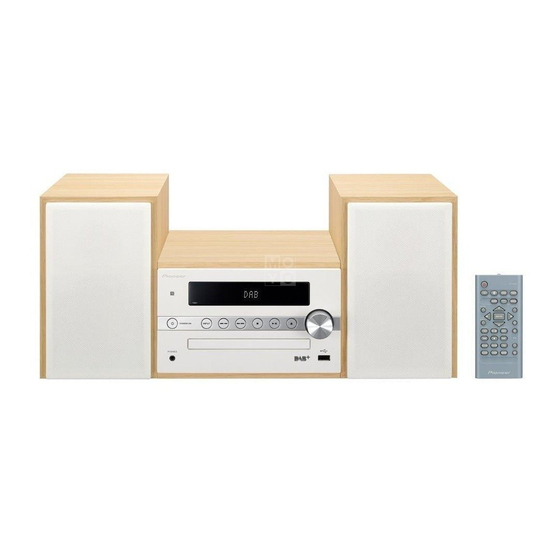Pioneer X-CM56 Руководство по эксплуатации - Страница 23
Просмотреть онлайн или скачать pdf Руководство по эксплуатации для Автомобильный приемник Pioneer X-CM56. Pioneer X-CM56 38 страниц. Cd receiver system
Также для Pioneer X-CM56: Руководство по эксплуатации (40 страниц)

Using the tuner
Note
• The backup function protects the memorised stations
for a few hours should there be a power failure or the
AC power cord become disconnected.
To recall a memorised station
Press PRESET +/– to select the desired station.
To scan the preset stations
The stations saved in the memory can be scanned
automatically. (Preset memory scan)
1
Press and hold PRESET +/–.
The preset number will appear and the programmed stations
will be tuned in sequentially, for 5 seconds each.
2
Press PRESET +/– again when the desired station is
located.
To erase entire preset memory
1
Press TUNER on the remote control.
2
Press
until "MEMORY CLEAR" appears.
Note
• All stations will be erased.
Using the Radio Data System (RDS)
(for European models only)
Radio Data System (RDS) is a system used by most FM
radio stations to provide listeners with various kinds of
information—the name of the station and the kind of show
they're broadcasting, for example.
One feature of RDS is that you can search by type of
program. For example, you can search for a station that's
broadcasting a show with the program type, Jazz Music.
Information provided by RDS
1
Press TUNER until "FM" appears on the display.
2
Press DISPLAY repeatedly.
Each time the DISPLAY is pressed, the display will switch as
follows:
Station name (PS)
Frequency
• When tuning in to a station other than an RDS station or
to an RDS station which sends weak signal, the display
will change in the following order:
NO RDS
FM 98.80 MHz
Programme type (PTY)
Radio text (RT)
Search for stations by Program Type
1
Press TUNER until "FM" appears on the display.
2
Press MENU and then press
appears on the display.
3
Press ENTER and then press / until "PTY" appears
on the display.
4
Press ENTER.
"SELECT" will appear for about 5 seconds.
5
Press /
to select the program type you want to hear.
Each time the button is pressed, the program type will
appear. If the button is held down, the program type will
appear continuously.
6
Whilst the selected program type is displayed (within 5
seconds), press ENTER.
After the selected program type has been lit for 2 seconds,
"SEARCH" will appear, and the search operation will start.
The Program Types displayed are as follows:
News – News
Current Affairs – Current
Affairs
Information – General
Information
Sport – Sport
Education – Educational
Drama – Radio plays, etc.
Cultures – National or regional
culture, theater, etc.
Science – Science and
technology
Varied Speech – Usually talk-
based material, such as quiz
shows or interviews.
Pop Music – Pop music
Rock Music – Rock music
Easy Listening – Easy listening
Light Classics M – 'Light'
classical music
Serious Classics – 'Serious'
classical music
Other Music – Music not fitting
above categories
Weather & Metr – Weather
reports
Finance – Stock market reports,
commerce, trading, etc.
Children's Progs – Programs
for children
• If the display has stopped flashing, start again from step
2. If the unit finds a desired program type, the
corresponding channel number will lit for about 8
seconds, and then the station name will remain it.
• If you want to listen to the same program type of another
station, repeat steps 2 - 6. The unit will look for the next
station.
• If no station can be found, "NOT FOUND" will appear for
4 seconds.
/
until "FM RDS"
Social affairs – Social affairs
Religion – Programs
concerning religion
Phone In – Public expressing
their views by Phone
Travel & Touring – Holiday-
type travel rather than traffic
announcements
Leisure & Hobby – Leisure
interests and hobbies
Jazz Music – Jazz
Country Music – Country
music
National Music – Popular
music in a language other than
English
Oldies Music – Popular music
from the '50s and' 60s
Folk Music – Folk music
Documentary – Documentary
Alarm Test – Broadcasting
when testing emergency
broadcast equipment or
receivers.
Alarm - Alarm! – Emergency
announcement made under
exceptional circumstances to
give warning of events
causing danger of a general
nature.
07
23
En
